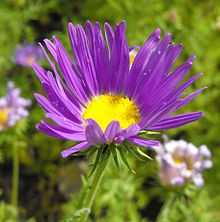Machaeranthera tanacetifolia
| Machaeranthera tanacetifolia | |
|---|---|
 | |
| Scientific classification | |
| Kingdom: | Plantae |
| (unranked): | Angiosperms |
| (unranked): | Eudicots |
| (unranked): | Asterids |
| Order: | Asterales |
| Family: | Asteraceae |
| Genus: | Machaeranthera |
| Species: | M. tanacetifolia |
| Binomial name | |
| Machaeranthera tanacetifolia (Kunth) Nees | |
| Synonyms | |
|
Machaeranthera coronopifolia | |
Machaeranthera tanacetifolia is a species of flowering plant in the aster family known by the common names tansyleaf tansyaster and Tahoka daisy. It is native to northern Mexico and the southwestern and central United States, where it grows in several types of habitat. It is an annual or biennial herb growing one or more branching stems up to about 70 centimeters in maximum height. The multilobed leaves are up to 12 centimeters long. The inflorescence bears one or more flower heads lined with spreading or curling, pointed phyllaries. The head has a center of many yellow disc florets and a fringe of many lavender to purple ray florets each 1 to 2 centimeters long. The fruit is a flat achene about a centimeter long including the pappus.
Uses
The Zuni people use an infusion of the flowers taken with other flowers for unspecified illnesses.[1]
References
- ↑ Camazine, Scott and Robert A. Bye 1980 A Study Of The Medical Ethnobotany Of The Zuni Indians of New Mexico. Journal of Ethnopharmacology 2:365-388 (p. 375)